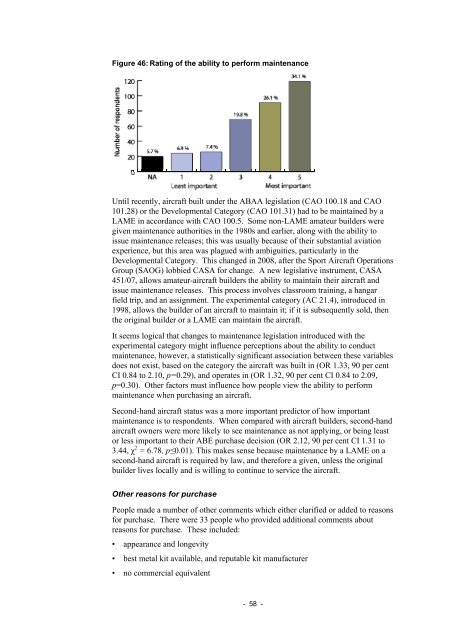Amateur-built and experimental aircraft - Australian Transport Safety ...
Amateur-built and experimental aircraft - Australian Transport Safety ...
Amateur-built and experimental aircraft - Australian Transport Safety ...
You also want an ePaper? Increase the reach of your titles
YUMPU automatically turns print PDFs into web optimized ePapers that Google loves.
Figure 46: Rating of the ability to perform maintenance<br />
Until recently, <strong>aircraft</strong> <strong>built</strong> under the ABAA legislation (CAO 100.18 <strong>and</strong> CAO<br />
101.28) or the Developmental Category (CAO 101.31) had to be maintained by a<br />
LAME in accordance with CAO 100.5. Some non-LAME amateur builders were<br />
given maintenance authorities in the 1980s <strong>and</strong> earlier, along with the ability to<br />
issue maintenance releases; this was usually because of their substantial aviation<br />
experience, but this area was plagued with ambiguities, particularly in the<br />
Developmental Category. This changed in 2008, after the Sport Aircraft Operations<br />
Group (SAOG) lobbied CASA for change. A new legislative instrument, CASA<br />
451/07, allows amateur-<strong>aircraft</strong> builders the ability to maintain their <strong>aircraft</strong> <strong>and</strong><br />
issue maintenance releases. This process involves classroom training, a hangar<br />
field trip, <strong>and</strong> an assignment. The <strong>experimental</strong> category (AC 21.4), introduced in<br />
1998, allows the builder of an <strong>aircraft</strong> to maintain it; if it is subsequently sold, then<br />
the original builder or a LAME can maintain the <strong>aircraft</strong>.<br />
It seems logical that changes to maintenance legislation introduced with the<br />
<strong>experimental</strong> category might influence perceptions about the ability to conduct<br />
maintenance, however, a statistically significant association between these variables<br />
does not exist, based on the category the <strong>aircraft</strong> was <strong>built</strong> in (OR 1.33, 90 per cent<br />
CI 0.84 to 2.10, p=0.29), <strong>and</strong> operates in (OR 1.32, 90 per cent CI 0.84 to 2.09,<br />
p=0.30). Other factors must influence how people view the ability to perform<br />
maintenance when purchasing an <strong>aircraft</strong>.<br />
Second-h<strong>and</strong> <strong>aircraft</strong> status was a more important predictor of how important<br />
maintenance is to respondents. When compared with <strong>aircraft</strong> builders, second-h<strong>and</strong><br />
<strong>aircraft</strong> owners were more likely to see maintenance as not applying, or being least<br />
or less important to their ABE purchase decision (OR 2.12, 90 per cent CI 1.31 to<br />
3.44, χ 2 = 6.78, p≤0.01). This makes sense because maintenance by a LAME on a<br />
second-h<strong>and</strong> <strong>aircraft</strong> is required by law, <strong>and</strong> therefore a given, unless the original<br />
builder lives locally <strong>and</strong> is willing to continue to service the <strong>aircraft</strong>.<br />
Other reasons for purchase<br />
People made a number of other comments which either clarified or added to reasons<br />
for purchase. There were 33 people who provided additional comments about<br />
reasons for purchase. These included:<br />
• appearance <strong>and</strong> longevity<br />
• best metal kit available, <strong>and</strong> reputable kit manufacturer<br />
• no commercial equivalent<br />
- 58 -

















